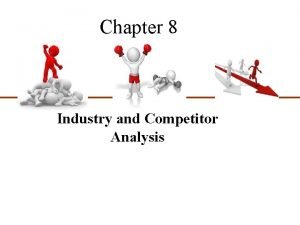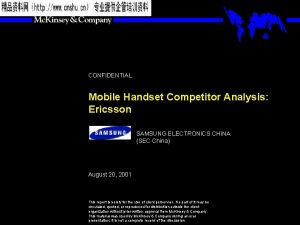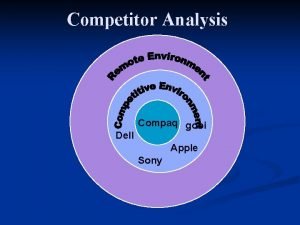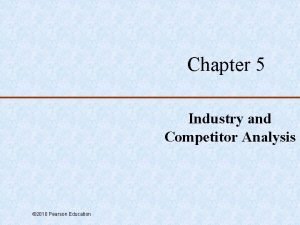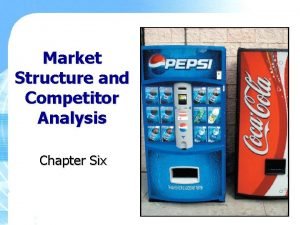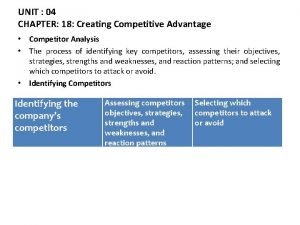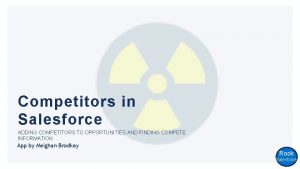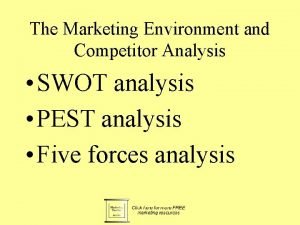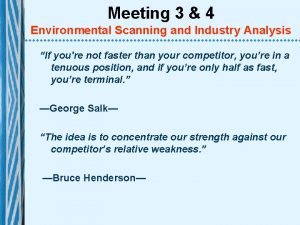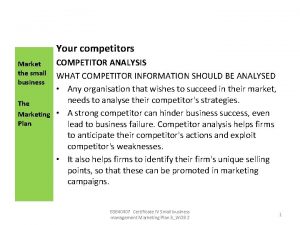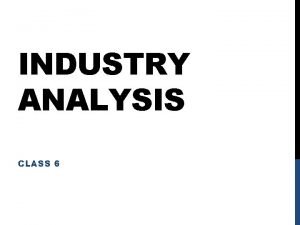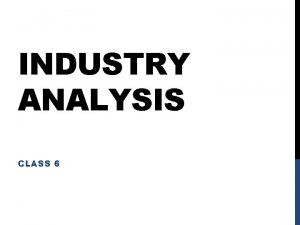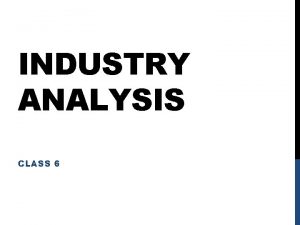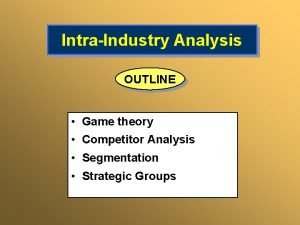Chapter 4 Industry and competitor analysis Industry analysis



























- Slides: 27

Chapter 4 Industry and competitor analysis Industry analysis Competitor analysis

Industry analysis When studying an industry, an entrepreneur must answer three questions before pursuing the idea of starting a firm: ü Is the industry accessible (is it a realistic place for a new venture to enter)? ü Does the industry contain markets that are ripe for innovation or are underserved? ü Are there positions in the industry that will avoid some of the negative aspects of the industry as a whole?

A new venture can use the five competitive forces model to assess the overall attractiveness of the industry it plans to enter and to determine if a favorable position exists in that industry. The five competitive forces that determine industry profitability (the model of Michael Porter) These forces determine industry profitability and the average rate of return for the firms in the industry. § Threat of substitutes The price that consumers are willing to pay for a product depends in part on the availability of substitute products. Example: There are few substitutes for prescription medicines, which is one of the reasons the pharmaceutical industry is so profitable. When a person is sick, he does not make any comment about the price of a medicine.

When close substitutes for a product exist, industry profitability is suppressed because consumers will choose not to buy when the price is too high. Example: If the price of the movie tickets gets too high, consumers can easily switch to rent videos. The firms in an industry often offer their customers amenities to reduce the likelihood of their switching to a substitute product. Example: The coffee sold at Starbucks is expensive. A consumer could easily find a less expensive cup of coffee at a donut shop or brew a coffee at home. To decrease the likelihood that consumers will choose one of these alternatives, Starbucks offers high-quality fresh coffee, a pleasant atmosphere and good service. Some Starbucks restaurants offer their customers access to computers and the Internet as ways of motivating them to remain loyal to Starbucks.

§ Threats of new entrants If the firms in an industry are highly profitable, the industry becomes a magnet to new entrants. There are barriers to entry that creates a disincentive for a new firm to enter an industry and keep the number of new entrants low. The barriers to entry are the followings: ü Economies of scale: industries that are characterized by large economies of scale are difficult for new firms to enter, unless they accept a cost disadvantage. Economies of scale occur when producing a product in large quantities it results in lower average costs.

Example: Intel has huge microchip factories that produce large quantities of chips, reducing the average cost of a chip. It would be difficult for a new entrant to match Intel’ s advantage in this area. ü Product differentiation Example: Industries such as the soft drink industry that are characterized by firms with strong brand are difficult to enter without spending a lot on advertising. It is very costly to compete against Pepsi or Coca-Cola. ü Capital requirements The need to invest large amounts of money to enter an industry is another barrier to entry. Many new firms do not have the capital to compete at this level.

ü Cost advantages independent of size These advantages are grounded in the firm’ s history. The existing competitors in an industry may have purchased land equipment in the past when the cost was less than new entrants would have to pay for the same assets today. ü Access to distribution channels: is difficult in crowded markets, such as the convenience store market. Example: A new sports drink to be placed on a convenience store shelf it has to display a product that is already there. ü Government and legal barriers: In knowledge-intensive industries, such as biotechnology and software, patents, trademarks and copyrights form major barriers to entry. Other industries, such as banking and broadcasting require the granting of a license by a public authority.

When a new firm tries to enter an industry with powerful barriers to entry, it must have a plan to overcome these barriers. Example: Firma Sun Microsystems was able to overcome the barriers to entry in many industries through a program of partnering with other forms (by forming strategic alliances). § Rivalry among existing firms In most industries, the profitability is dependent on the level of competition among the firms already competing in these industries. In industries with high competition the prices are pushed below the level of costs and firms have losses or the profit margins are small (for example in the personal computer industry).

Other industries are less competitive (such as specialized medical equipment industry) and the profit margins are higher. § Bargaining power of suppliers In some cases suppliers influence the profitability of industries to which they sell by raising prices or reducing the quality of the components. If a supplier reduces the quality of the components it supplies, the quality of the finished product will decrease and the manufacturer will have to lower its price. Example: Intel is a powerful supplier of Pentium chips to the PC industry. Intel can command a premium price from the PC manufacturers, thus affecting the overall profitability of the PC industry.

The factors that have an impact on the ability of suppliers to influence the profitability of the industries they serve are the following: ü Supplier concentration: when there are only a few suppliers that supply a critical product to a large number of buyers, the supplier has an advantage. Example: In the pharmaceutical industry, few drug manufacturers sell to thousands of doctors and patients. ü Switching costs: if switching costs are high, a buyer will be less likely to switch suppliers. Example: Suppliers often provide their largest buyers with specialized software that makes it easy to buy their products. After the buyer spends time and effort learning the supplier’ s ordering and inventory management systems, it will be less likely to want to spend time and effort learning another supplier’ s system.

ü Attractiveness of substitutes: supplier’ s power increases if there are no attractive substitutes for the products/services it offers. Example: There is little the computer industry can do when Microsoft and Intel raise their prices because there are no substitutes for their firms’ products. ü Threat of forward integration: the power of a supplier increases if there is a possibility that the supplier might enter the buyer’ s industry. Example: Microsoft’ s power as a supplier of computer operating systems is enhanced by the threat that it might enter the PC industry.

§ Bargaining power of buyers Buyers can influence the profitability of the industries from which they purchase by demanding price decreases or increases in quality. Example: The automobile industry is dominated by few large companies that buy products from thousands of suppliers in different industries. If the car manufacturers demand price reductions or better quality for the same price, the profitability of suppliers would suffer. The factors that affect buyers` ability to exert pressure on suppliers and influence the profitability of the industries from which they buy are the following: ü Buyer group concentration: if the buyers are concentrated, meaning that there are only a few large buyers and they buy from a large number of suppliers they can pressure the suppliers to lower costs and thus affect the profitability of the industry from which they buy.

ü Buyer` costs: the greater the importance of an item is to a buyer, the more sensitive the buyer will be to the price it pays. ü Degree of standardization of supplier` s products: the degree to which a supplier` s product differs from its competitors affects the buyer` s bargaining power. A buyer who purchases a standard or undifferentiated product will look for a supplier who offers the best combination of price and service. ü Threat of backward integration: the power of a buyer increases if there is a threat the buyer might enter the supplier` s industry. Example: The PC industry can keep the price down by threatening to make its own monitors if the price gets too high.

The value of the five forces model This model helps a firm understand the dynamics of the industry it plans to enter and determine whether it should enter a particular industry. The ways this model can be used are the following: The model can be used to assess the attractiveness of an industry or a specific position in an industry by determining the level of threat to industry profitability for each of the forces. If several of the threats to industry profitability are high, the firm should reconsider entering the industry or think carefully about the position it will occupy in the industry.

Threat to industry profitability Competitive forces Threat of substitutes Threat of new entrants Rivalry among existing firms Bargaining power of suppliers Bargaining powers of buyers Low Medium High

Example: In the restaurant industry the threat of substitute products, the threat of new entrants and the rivalry among existing firms are high. For certain restaurants, such as fresh-seafood restaurants, the bargaining power of suppliers may also be high (the number of seafood suppliers is relatively small compared to the number of beef and chicken suppliers). A firm that enters the restaurant industry has several forces working against it and it must establish a favorable position. The model can be used to answer several questions: Question 1: Is the industry a realistic place for a new firm to enter? This question can be answered by looking at the overall attractiveness of an industry and by assessing whether the window of opportunity is open or closed.

Question 2: If we enter the industry, can our firm do a better job than the industry as a whole in avoiding or diminishing the impact of the forces that suppress industry profitability? A new firm can enter an industry with a fresh brand, innovative ideas and a world-class management team and perform better than the firms already in that industry. Example: Having innovative ideas Google entered the Internet search engine Industry and displaced Yahoo! as the market leader. Question 3: Is there a unique position in the industry that avoids or diminishes the forces that suppress industry profitability?

Question 4: is there a superior business model that can be put in place that would be hard for competitors to duplicate? Sometimes the largest firms in an industry prefer to maintain their strategies providing an opening for a start-up to try something new. Example: When Dell started selling computers directly to consumers, its largest rivals (Hewlett-Packard, Compaq, IBM) were not able to respond. They were locked into a strategy of selling through retailers.

Industry types and the opportunities they offer ü Emerging industries An emerging industry is a new industry in which standard operating procedures have to be developed. The firm that enter such an industry can capture a first-mover advantage. Because a high level of uncertainty characterizes emerging industries, any opportunity that is captured may be short lived. Many new firms enter emerging industries because the barriers to entry are low and there is not established a pattern of rivalry.

ü Fragmented industries A fragmented industry is characterized by a large number of firms of equal size. The opportunity existing for new firms is to consolidate the industry and establish a leader position. In industry consolidation, the smaller firms are acquired or leave the industry and few larger companies take over the majority of the business. Example: In the video rental industry in the USA there were many small video stores. After Blockbuster entered the industry, through internal growth and acquisitions, this firm grew quickly and consolidated a previously fragmented industry.

ü Mature industries They are experiencing slow or no increase in demand, have numerous repeat (rather than new) customers and have limited product innovation. There is an opportunity for a new firm to innovate processes and products/services. Example: In 1996 White Wave a company that makes vegetarian food products introduced Silk Soymilk, which has quickly become the best-selling soy milk in the country. This product is not really milk at all, it is a soybeanbased beverage that looks like milk and it is a healthy substitute for milk.

ü Declining industries They are industries that are experiencing a reduction in demand. Entrepreneurial firms can use the following strategies: a). The leadership strategy in which the firm tries to become the leader in the industry. This is a rare strategy for a start-up in a declining industry. b). The niche strategy which focuses on a narrow segment of the industry that might grow through product or process innovation. c). The cost reduction strategy is accomplished through achieving lower costs than the other competitors through process improvements.

ü Global industries They are industries that are experiencing significant international sales. Many start-ups enter global industries and they try to address international rather domestic markets. The most common strategies followed by firms in global industries are the multidomestic strategy and the global strategy. Firms that pursue a multidomestic strategy compete for market share on a country-by-country basis and vary their products or services to meet the demands of the local market. Firms pursuing a global strategy use the same basic approach in all foreign markets.

The choice between these two strategies depends on how similar consumers` tastes are from market to market. Example: Food companies pursue a multidomestic strategy because food preferences vary significantly from country to country. Firms that sell more universal products, such as athletic shoes pursue a global strategy.

Competitor analysis It helps a firm understand the positions of its major competitors and the opportunities that are available to obtain a competitive advantage. Identifying competitors is the first step in a competitor analysis and it is more difficult because most companies run several businesses and they have a set of competitors. The different types of competitors a business face are: ü Direct competitors are firms that offer products identical or similar to the products of the firm completing the analysis. These competitors are the most important because they address the same customers as the local firm. It is very difficult for a start-up to attract customers even when it has a better product.

ü Indirect competitors offer substitutes to the products the firm completing the analysis sells. ü Future competitors are firms that are not yet direct or indirect competitors but could become at any time. It is impossible for a company to identify all its direct and indirect competitors. It is easier for a firm to complete its competitive analysisif it identifies its top 5 to 10 direct competitors and its top 5 to 10 indirect and future competitors. There a number of ways that a firm can ethically obtain information about its competitors: attend conferences and trade shows; read industry related books, magazines, Web sites; talk to customers about what motivated them to buy your product; purchase competitors` products to understand their features, advantages and disadvantages.

Completing a competitive analysis grid is a tool for organizing the information a firm collects about its competitors. It can help a firm understands its position against the competitors, provides ideas for markets to pursue and identifies its primary sources of competitive advantage. Information about its competitors can refer to: product features, brandname recognition, access to distribution channels, quality of products, ease of use, price, marketing support, quality of customer service.
 Competitors analysis grid
Competitors analysis grid Lehmann and winer competitor analysis
Lehmann and winer competitor analysis Industry market feasibility analysis
Industry market feasibility analysis Myk pono competitor analysis
Myk pono competitor analysis Competitor analysis theory
Competitor analysis theory Nokia competitor analysis
Nokia competitor analysis Ericsson axd 320 repair
Ericsson axd 320 repair Analysis apple streetjournal fy 2b sony
Analysis apple streetjournal fy 2b sony Pearson education competitors
Pearson education competitors Competitor analysis theory
Competitor analysis theory Competitor analysis grid
Competitor analysis grid Chapter 18 creating competitive advantage
Chapter 18 creating competitive advantage The attacking firm goes head-to-head with its competitor.
The attacking firm goes head-to-head with its competitor. Competitor of starbucks
Competitor of starbucks Marsello competitor
Marsello competitor Competitor tracking salesforce
Competitor tracking salesforce Competitor analisys
Competitor analisys Sports competitor worksheet
Sports competitor worksheet Competition comparison chart
Competition comparison chart Competitor intelligence should be gathered mcq
Competitor intelligence should be gathered mcq Environmental scanning and industry analysis
Environmental scanning and industry analysis Environmental scanning and industry analysis
Environmental scanning and industry analysis The corporation's task environment
The corporation's task environment Environmental scanning and industry analysis
Environmental scanning and industry analysis Macroeconomic and industry analysis
Macroeconomic and industry analysis Chapter 18 industry and urban growth
Chapter 18 industry and urban growth Swot analysis of gaming industry
Swot analysis of gaming industry Swot analysis of dairy industry
Swot analysis of dairy industry




